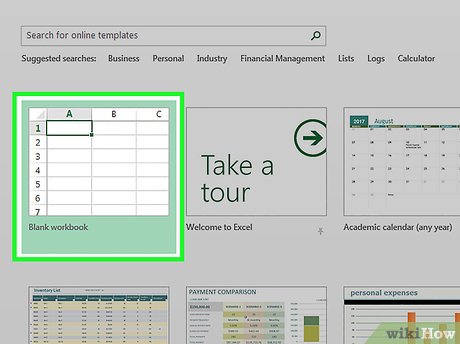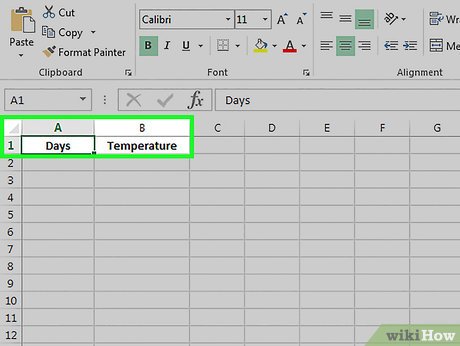How to Make a Bar Graph in Excel
Part 1 of 2:
Adding Data
-
 Open Microsoft Excel. It resembles a white "X" on a green background.
Open Microsoft Excel. It resembles a white "X" on a green background.- If you want to create a graph from pre-existing data, instead double-click the Excel document that contains the data to open it and proceed to the next section.
-
 Click Blank workbook (PC) or Excel Workbook (Mac). It's in the top-left side of the template window.
Click Blank workbook (PC) or Excel Workbook (Mac). It's in the top-left side of the template window. -
 Add labels for the graph's X- and Y-axes. To do so, click the A1 cell (X-axis) and type in a label, then do the same for the B1 cell (Y-axis).
Add labels for the graph's X- and Y-axes. To do so, click the A1 cell (X-axis) and type in a label, then do the same for the B1 cell (Y-axis).- For example, a graph measuring the temperature over a week's worth of days might have "Days" in A1 and "Temperature" in B1.
-
 Enter data for the graph's X- and Y-axes. To do this, you'll type a number or word into the A or B column to apply it to the X- or Y- axis, respectively.
Enter data for the graph's X- and Y-axes. To do this, you'll type a number or word into the A or B column to apply it to the X- or Y- axis, respectively.- For example, typing "Monday" into the A2 cell and "70" into the B2 field might show that it was 70 degrees on Monday.
-
 Finish entering your data. Once your data entry is complete, you're ready to use the data to create a bar graph.
Finish entering your data. Once your data entry is complete, you're ready to use the data to create a bar graph.
Part 2 of 2:
Creating a Graph
-
 Select all of your data. To do so, click the A1 cell, hold down ⇧ Shift, and then click the bottom value in the B column. This will select all of your data.
Select all of your data. To do so, click the A1 cell, hold down ⇧ Shift, and then click the bottom value in the B column. This will select all of your data.- If your graph uses different column letters, numbers, and so on, simply remember to click the top-left cell in your data group and then click the bottom-right while holding ⇧ Shift.
-
 Click the Insert tab. It's at the top of the Excel window, just right of the Home tab.
Click the Insert tab. It's at the top of the Excel window, just right of the Home tab. -
 Click the "Bar chart" icon. This icon is in the "Charts" group below and to the right of the Insert tab; it resembles a series of three vertical bars.
Click the "Bar chart" icon. This icon is in the "Charts" group below and to the right of the Insert tab; it resembles a series of three vertical bars. -
 Click a bar graph option. The templates available to you will vary depending on your operating system and whether or not you've purchased Excel, but some popular options include the following:
Click a bar graph option. The templates available to you will vary depending on your operating system and whether or not you've purchased Excel, but some popular options include the following:- 2-D Column - Represents your data with simple, vertical bars.
- 3-D Column - Presents three-dimensional, vertical bars.
- 2-D Bar - Presents a simple graph with horizontal bars instead of vertical ones.
- 3-D Bar - Presents three-dimensional, horizontal bars.
-
 Customize your graph's appearance. Once you decide on a graph format, you can use the "Design" section near the top of the Excel window to select a different template, change the colors used, or change the graph type entirely.
Customize your graph's appearance. Once you decide on a graph format, you can use the "Design" section near the top of the Excel window to select a different template, change the colors used, or change the graph type entirely.- The "Design" window only appears when your graph is selected. To select your graph, click it.
- You can also click the graph's title to select it and then type in a new title. The title is typically at the top of the graph's window.
Sample Bar Graphs
 Sample Horizontal Bar Graph
Sample Horizontal Bar Graph Sample Vertical Bar Graph
Sample Vertical Bar Graph Sample Stacked Bar Graph
Sample Stacked Bar Graph5 ★ | 1 Vote
You should read it
- How to Make a Line Graph in Microsoft Excel
- Detailed instructions on how to graph in excel
- How to Do Trend Analysis in Excel
- Instructions on how to graph in Excel
- How to Add a Graph to Microsoft Word
- How to implement a graph data structure in Golang
- Search algorithm by width
- How to Import, Graph, and Label Excel Data in MATLAB
May be interested
- Draw a bar graph with positive and negative values in Excel
 the following article details how to create a positive and negative column chart in excel.
the following article details how to create a positive and negative column chart in excel. - Facebook gradually improves Graph Search
 facebook said its search system is capable of processing an average of 1 billion searches a day and developers are still actively working to improve the tool.
facebook said its search system is capable of processing an average of 1 billion searches a day and developers are still actively working to improve the tool. - How to Do Trend Analysis in Excel
 this wikihow teaches you how to create a projection of a graph's data in microsoft excel. you can do this on both windows and mac computers. open your excel workbook. double-click the excel workbook document in which your data is stored.
this wikihow teaches you how to create a projection of a graph's data in microsoft excel. you can do this on both windows and mac computers. open your excel workbook. double-click the excel workbook document in which your data is stored. - 5 useful Microsoft Excel formulas for calculating taxes
 you can spend big money to hire an experienced accountant handles this, or make use of excel power immediately to arrange things in order. here are five recipes that can make your life 'breathable' than in 'season' tax.
you can spend big money to hire an experienced accountant handles this, or make use of excel power immediately to arrange things in order. here are five recipes that can make your life 'breathable' than in 'season' tax. - How to draw straight lines and arrows in Excel - Draw shapes in Excel
 there are many different ways to draw straight lines and arrows in excel. lines and arrows in excel are often used to draw mind maps in excel or graph functions in excel.
there are many different ways to draw straight lines and arrows in excel. lines and arrows in excel are often used to draw mind maps in excel or graph functions in excel. - How to Add a Second Y Axis to a Microsoft Excel Chart
 it would be helpful if you knew how to add multiple data lines to an excel chart. however, with data with many units, you may find it difficult to create the graph you need. don't worry, not only can you do it, you can do it very easily!
it would be helpful if you knew how to add multiple data lines to an excel chart. however, with data with many units, you may find it difficult to create the graph you need. don't worry, not only can you do it, you can do it very easily! - How to rename data series in Excel chart
 data series in excel is a collection of data displayed in a row or column shown in a chart or graph. and during data processing there will be times when you need to change the name of the data series. in the chart.
data series in excel is a collection of data displayed in a row or column shown in a chart or graph. and during data processing there will be times when you need to change the name of the data series. in the chart. - How to create charts in excel 2007 is extremely simple!
 detailed instructions on how to create charts in excel 2007 are extremely simple for you to read
detailed instructions on how to create charts in excel 2007 are extremely simple for you to read - Test Microsoft Excel P13
 in this article, network administrators will continue to learn about excel software through extremely interesting multiple-choice questions below. try to see how many questions you will make.
in this article, network administrators will continue to learn about excel software through extremely interesting multiple-choice questions below. try to see how many questions you will make. - Invite to see malware with visual images with VirusTotal Graph
 virustotal has just released a new feature - graph - which allows users to visualize data from available files.
virustotal has just released a new feature - graph - which allows users to visualize data from available files.














 How to Compare Data in Excel
How to Compare Data in Excel How to Add Header Row in Excel
How to Add Header Row in Excel How to Add a Column in a Pivot Table
How to Add a Column in a Pivot Table How to Make a Line Graph in Microsoft Excel
How to Make a Line Graph in Microsoft Excel How to Create an Inventory List in Excel
How to Create an Inventory List in Excel How to Open a Password Protected Excel File
How to Open a Password Protected Excel File